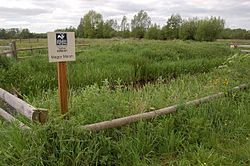Magor Marsh facts for kids
Quick facts for kids Magor Marsh Reserve |
|
|---|---|

Magor Marsh Nature Reserve in mid-May
|
|
| Lua error in Module:Location_map at line 420: attempt to index field 'wikibase' (a nil value). | |
| Type | Nature Reserve |
| Location | Monmouthshire |
| Nearest city | Magor |
| OS grid | ST 428 866 |
| Area | 36 hectares (0.360 km2; 0.139 sq mi) |
| Operated by | Gwent Wildlife Trust |
| Hiking trails | The Dragonfly Trail and The Butterfly Trail |
| Website | Gwent Wildlife Trust |
Magor Marsh is a special nature reserve in Wales, right by the Severn Estuary. It's a huge wetland area, about 90 acres big, and it's looked after by the Gwent Wildlife Trust. This amazing place has many different natural areas. You can find damp hay meadows, sedge fens, reed beds, scrub, and wet woodland. There are also lots of small drainage channels called reens, and a big pond.
Magor Marsh is known as the best place in Wales for wetland beetles and soldier-flies. Its old drainage system and other features have stayed the same since the 1300s! In March 2020, the reserve was even shown on the BBC One TV show Countryfile.
Contents
What is Magor Marsh Made Of?
The ground at Magor Marsh is mostly made of peat. This is a type of soil formed from partly decayed plants. The peat here is about 15 feet deep! Below the peat, there's a layer of alluvium. This is soil that was laid down by the Severn Estuary over many years. To keep the peat healthy, the water level in the marsh needs to stay close to the surface.
Amazing Wildlife
Magor Marsh is home to a huge variety of plants and animals. It's a fantastic place to see nature up close!
Plants of the Marsh
There are two hay meadows at Magor Marsh. These meadows are cared for using old-fashioned methods. Animals graze in them during autumn and winter. In mid-summer, the hay is cut to provide food for winter. By late spring, the fields are bursting with colorful flowers.
You might spot flowers like lady's smock, ragged robin, and bright yellow flag. Other plants include lesser spearwort and meadow thistle. In the reed beds, you'll find tall common reed, teasel, hemp agrimony, and purple loosestrife. The reens have plants like water horsetail, reedmace, and marsh marigold. In the wet woodland, common trees are osier, crack willow, and sallow.
Animals of the Marsh
Magor Marsh is a breeding ground for many birds, including the common redshank and common snipe. In the reeds, you can hear and see birds like the reed warbler, grasshopper warbler, cetti's warbler, reed bunting, and chiffchaff.
The large pond is home to birds like the water rail, coot, grey heron, little grebe, moorhen, little egret, Eurasian teal, shoveler, and the colorful kingfisher. In the reens, you might spot a grass snake, great silver beetle, smooth newt, or even an otter. The wet woodland is where you can find the great spotted woodpecker and the musk beetle. If you visit in summer, you might hear the call of a cuckoo.
The meadows are great for butterflies like the orange tip and meadow brown. The reens also provide a home for the beautiful azure damselfly. A rare type of moth larva, called the marbled marble (Celypha woodiana), was found here in 2019. This was the first time it had been officially confirmed in Wales! The European water vole also lives in the reserve.
Gallery
-
Swans on Christmas Day, 2005
-
Looking south along a drainage ditch, towards the River Severn
Images for kids






